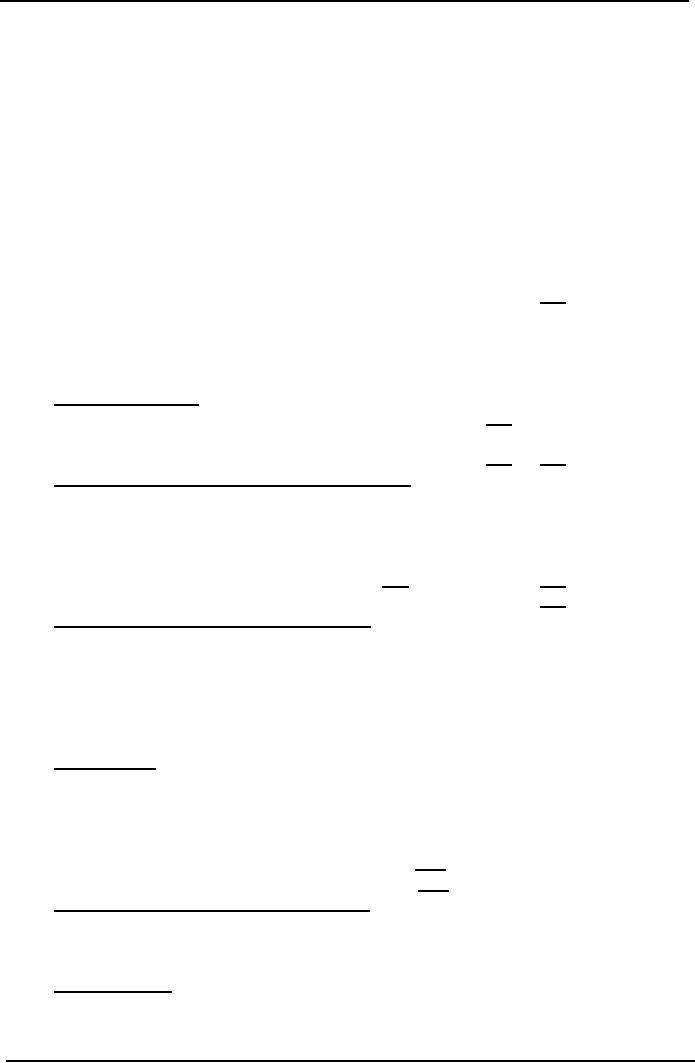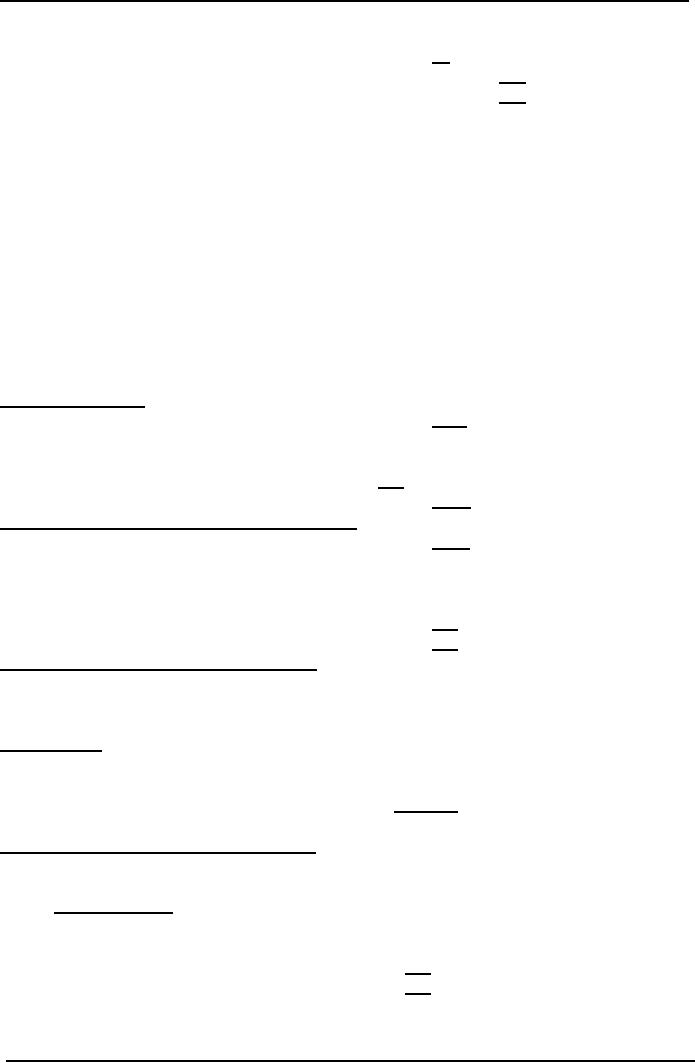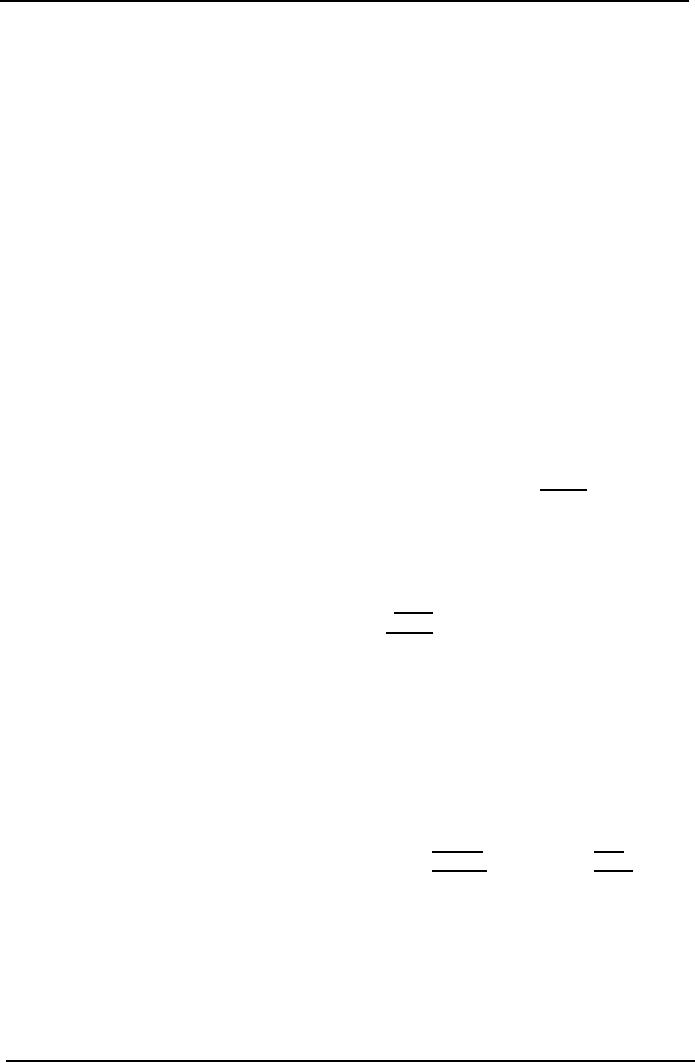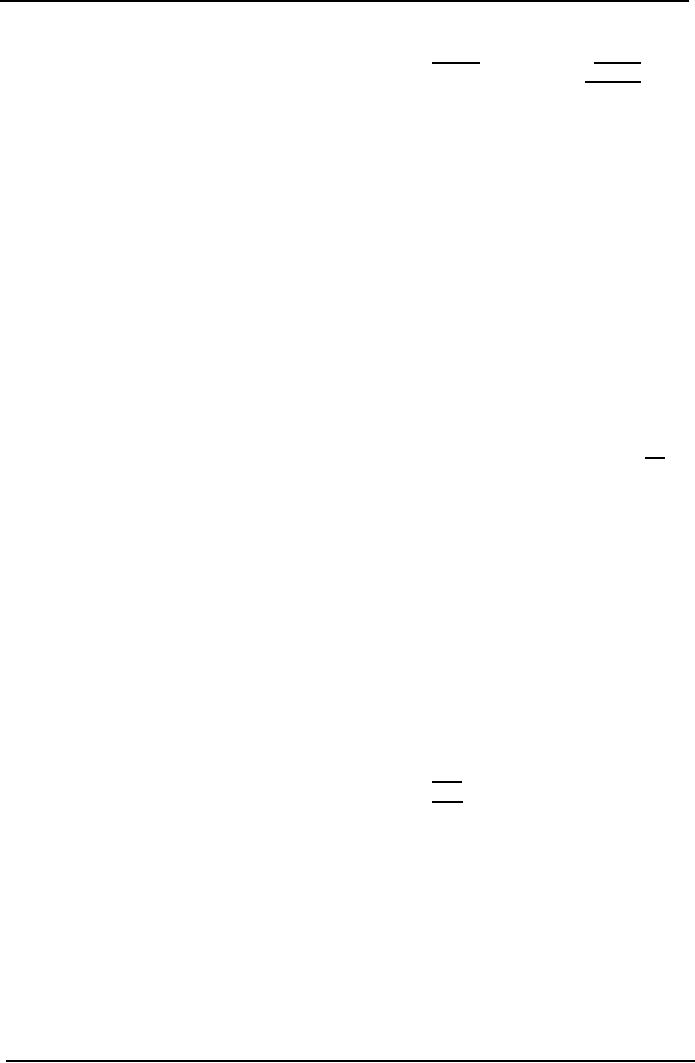 |
PROCESS COSTING SYSTEM:Cost of Production Report, Quantity Schedule |
| << PROCESS COSTING SYSTEM:Data Collection, Cost of Completed Output |
| PROCESS COSTING SYSTEM:Normal Loss at the End of Process >> |

Cost
& Management Accounting
(MGT-402)
VU
LESSON#
20, 21, & 22
PROCESS
COSTING SYSTEM
Practice
Question
Q.
1
Mini
Soap Manufacturing unit completed
and transferred out 600
soaps to department-11 at
the
end
of the week. In department-11
500 soaps completed and
transferred out. Units which
were
still
in process 100 (100% material,
Conversion cost 60%).
Rs.
Cost
received from preceding
department
540
Following
costs were incurred by
department-11:
Direct
Material
150
Direct
Labor
112
Factory
overhead
168
430
970
Required:
Prepare cost of production
report
Cost
of Production Report
Department-II
I-Quantity
Schedule:
Units
received previous
department
600
Unites
completed and transfer to
next
department
500
Units
still in process
100
600
II-Cost
Accumulated in the Department /
Process:
Cost
received from preceding
department
Rs.
540
Cost
added by department-11:
Direct
Material
150
Direct
Labor
112
Factory
overhead
168
430
970
III-Calculation
of Equivalent Units
Produced:
(100%
of completed units + % of units in
process)
Units
completed in department-I = 500 + 100 =
600
Direct
Material:
500+(100x100%)
=
600
Direct
Labor :
500+(100x60%)
=
560
F.O.H
:
500+(100x60%)
=
560
IV-
Unit Cost:
As
to Previous department:
Total
cost / Number of Equivalent
units produced = 540 / 600 =
0.90
As
to Direct Material:
150
/ 600 = 0.25
As
to Direct Labor:
112
/ 560 = 0.20
As
to F.O.H:
135
/ 900 = 0.15
1.65
V-
Apportionment of the Accumulated
Cost:
Cost
of units transferred to the
next department
No
of completed units x Total cost
per unit:
500
x
1.65
=
825
Units
in process:
Cost
of preceding department 100 x
0.9
=
90
Direct
Material
100
x 0.25
=
25
139

Cost
& Management Accounting
(MGT-402)
VU
Direct
Labor
60
x 0.20
=
12
F.O.H
60
x 0.30
=
18
145
970
Q.
2
Mini
Soap Manufacturing unit
started to incurring cost in
first department for 1000
soaps. At the
end
of the week 600 soaps
were completed, 300 still in
process and 100 units
lost. 100% of direct
material
had been incurred but
75% conversion cost was
yet incurred on the
incomplete work.
The
detail of costs incurred by
the department:
Rs.
Direct
material 500
Direct
labor
225
Factory
overhead
135
Required:
Prepare cost of production
report
Cost
Of Production Report
Department-I
I-Quantity
Schedule:
Units
started in process
1000
Units
completed in the department
600
Units
still in process
300
Units
Lost (Normal)
100
1,000
II-Cost
Accumulated in the Department /
Process:
Total
Rs
Direct
Material
500
Direct
Labor
225
F.O.H
135
860
III-Calculation
of Equivalent Units
Produced:
Direct
material 600+ (300x100%)
=
900
Direct
labor
600+
(300x75%)
=
825
F.O.H
600+
(300x75%)
=
825
IV-
Unit Cost:
Direct
material
500/900
=
0 .555
Direct
labor
225/825
=
0.27272
F.O.H
135/825
=
0.163636
0.992
V-
Apportionment of the Accumulated
Cost:
Cost
of units transferred to the
next department
600
x
0.992
595
Work
in process:
Direct
Material
300
x 0.5555 = 167
Direct
Labor
300
x 0.2727 = 61
F.O.H
300
x 0.16363 = 37
265
860
140

Cost
& Management Accounting
(MGT-402)
VU
Normal
Loss in First
Department.
Loss
of units during manufacturing
process is, in many industries, a
normal condition. This
loss
may
be due to unavoidable spoiled work or
wastage, evaporation or shrinkage etc. In
other words,
normal
loss represents the
lost units expected to arise even
under efficient operating
conditions.
Such
a loss is inherent in manufacturing
operations and cannot be avoided,
for this reason; cost
of
normal
loss is absorbed by the good
units produced. It has the
affect of increasing unit
cost of
good
output. Total cost of the
department is not divided by all
units processed, instead. It
is
divided
only by the good units
produced.
Practice
Question
During
the month of January 2006
direct materials worth Rs.
300,000 were issued to
produce
26,000
units of finished product.
Direct labor to process
these materials totaled Rs.
110,000 and
factory
overhead Rs. 55,000. During
the month processing of
20,000 units were completed
and
these
units were transferred to
next department, whereas, 1,000
units were lost during
processing
(the
loss is regarded as normal).
All of the direct materials
had been issued for
the units in process
at
the end of month, but
these units were only
40% converted. Cost of
Production Report for
the
month
'based on above inforn1ation is given
below:
Ginza
Beauty products
Department
I
Cost
of Production Report
For
the Month of January,
2006.
Quantity
Schedule
Units
started in process
26,000
Units
transferred to next
department
20,000
Units
still in process
5,000
(100%
materials,
40% labor & FOH)
Units
lost in process
Normal
loss
1,000
26,000
Cost
accumulated to Department
Total
Units
Rs.
Rs.
Cost
added by the department:
Direct
materials
300,000
12
Direct
labor
110,000
5
Factory
overhead
55,000
2.50
Total
cost to be accounted for
465,000
19.50
Cost
Apportioned
Transferred
to next department
(20,000
units x Rs. 19.50)
Rs.
390,000
Rs.
Work
in process ending inventory:
Direct
materials (5000 units x Rs.
12.00)
60,000
141

Cost
& Management Accounting
(MGT-402)
VU
Direct
labor (5000 units x 40% x
Rs. 5.00)
10,000
FOH
(5000 units x 40% x Rs.
2.50)
5,000
75,000
465,000
Whenever,
normal loss occurs in the
first department, it requires no
separate calculation.
Number
of
units so lost is ignored while
computing equivalent production.
The result is a decrease
in
equivalent
production quantity (the
denominator) and an increase in
unit cost.
In
the above cost of production
report, equivalent production of
department I include
20,000
completed
units plus 5,000 units in
work in process ending inventory
adjusted for their stage
of
completion.
Normal
Loss in Departments Subsequent to the
First.
It
is stated earlier that cost
of normal loss is absorbed by
the good units produced and
this is done
by
omitting lost units from
equivalent production quantity.
Same procedure applies when
units are
lost
during processing in a department
subsequent to the
first.
However,
here an adjustment
in unit cost from preceding department
is
also necessary. In the above
report
total
cost of Rs. 390,000 received
from department I was for
20,000 units. Out of these
20,000
units,
500 units were lost.
Now total cost of Rs.
390,000 applies only to
19,500 remaining good
units.
This decrease
in
number of units will cause
an increase
in
unit cost from preceding
department.
In
department 2, after the lost
units have been taken into
account, unit cost from
department I
come
to Rs. 20.00 (i.e. Rs.
390,000 + 19,500 units).
This increase of Rs. 0.50
(i.e. Rs. 20.00 less
Rs.
19.50)
is called adjustment for
lost units.
The
adjustment for lost units
can be computed by anyone of the
following two methods. For
the
purpose
of explanation assume the
following:
Assembling
department received from
cutting department 32,000 units at a
total cost of
Rs.120,000
resulting in a unit cost of
Rs. 3.75. During processing
in assembling department
2,000
units
were lost. The lost
units are considered as
normal.
First
Method: Firstly
find unit cost received
from preceding department
after adjustment for
lost
units
and then deduct it from the
unit cost before adjustment;
the difference is adjustment
per unit.
Unit
cost after adjustment is
calculated by dividing total
cost from preceding
department by good
units
left after the
loss.
Computations
are illustrated as
follow:
Rs
Unit
cost after adjustment
Rs.
120,000/30,000 units
4.00
Unit
cost before adjustment
3.75
Adjustment
per unit
0.25
Second
Method: Find
total cost of lost units at
which they are received by
the department. This
total
cost is now to be absorbed by
the remaining good units.
How much cost is to be
absorbed by
each
good unit is computed by
dividing remaining good units
into total cost of lost
units. The
resulting
figure is adjustment per
good unit.
These
computations are explained as
follows:
Cost
of lost units accumulated upto
preceding department
2,000
units x Rs. 3.75
Rs.
7,500
Adjustment
per unit Rs. 7.500/30,000
units
Rs.
0.25
142
Table of Contents:
- COST CLASSIFICATION AND COST BEHAVIOR INTRODUCTION:COST CLASSIFICATION,
- IMPORTANT TERMINOLOGIES:Cost Center, Profit Centre, Differential Cost or Incremental cost
- FINANCIAL STATEMENTS:Inventory, Direct Material Consumed, Total Factory Cost
- FINANCIAL STATEMENTS:Adjustment in the Entire Production, Adjustment in the Income Statement
- PROBLEMS IN PREPARATION OF FINANCIAL STATEMENTS:Gross Profit Margin Rate, Net Profit Ratio
- MORE ABOUT PREPARATION OF FINANCIAL STATEMENTS:Conversion Cost
- MATERIAL:Inventory, Perpetual Inventory System, Weighted Average Method (W.Avg)
- CONTROL OVER MATERIAL:Order Level, Maximum Stock Level, Danger Level
- ECONOMIC ORDERING QUANTITY:EOQ Graph, PROBLEMS
- ACCOUNTING FOR LOSSES:Spoiled output, Accounting treatment, Inventory Turnover Ratio
- LABOR:Direct Labor Cost, Mechanical Methods, MAKING PAYMENTS TO EMPLOYEES
- PAYROLL AND INCENTIVES:Systems of Wages, Premium Plans
- PIECE RATE BASE PREMIUM PLANS:Suitability of Piece Rate System, GROUP BONUS SYSTEMS
- LABOR TURNOVER AND LABOR EFFICIENCY RATIOS & FACTORY OVERHEAD COST
- ALLOCATION AND APPORTIONMENT OF FOH COST
- FACTORY OVERHEAD COST:Marketing, Research and development
- FACTORY OVERHEAD COST:Spending Variance, Capacity/Volume Variance
- JOB ORDER COSTING SYSTEM:Direct Materials, Direct Labor, Factory Overhead
- PROCESS COSTING SYSTEM:Data Collection, Cost of Completed Output
- PROCESS COSTING SYSTEM:Cost of Production Report, Quantity Schedule
- PROCESS COSTING SYSTEM:Normal Loss at the End of Process
- PROCESS COSTING SYSTEM:PRACTICE QUESTION
- PROCESS COSTING SYSTEM:Partially-processed units, Equivalent units
- PROCESS COSTING SYSTEM:Weighted average method, Cost of Production Report
- COSTING/VALUATION OF JOINT AND BY PRODUCTS:Accounting for joint products
- COSTING/VALUATION OF JOINT AND BY PRODUCTS:Problems of common costs
- MARGINAL AND ABSORPTION COSTING:Contribution Margin, Marginal cost per unit
- MARGINAL AND ABSORPTION COSTING:Contribution and profit
- COST – VOLUME – PROFIT ANALYSIS:Contribution Margin Approach & CVP Analysis
- COST – VOLUME – PROFIT ANALYSIS:Target Contribution Margin
- BREAK EVEN ANALYSIS – MARGIN OF SAFETY:Margin of Safety (MOS), Using Budget profit
- BREAKEVEN ANALYSIS – CHARTS AND GRAPHS:Usefulness of charts
- WHAT IS A BUDGET?:Budgetary control, Making a Forecast, Preparing budgets
- Production & Sales Budget:Rolling budget, Sales budget
- Production & Sales Budget:Illustration 1, Production budget
- FLEXIBLE BUDGET:Capacity and volume, Theoretical Capacity
- FLEXIBLE BUDGET:ANALYSIS OF COST BEHAVIOR, Fixed Expenses
- TYPES OF BUDGET:Format of Cash Budget,
- Complex Cash Budget & Flexible Budget:Comparing actual with original budget
- FLEXIBLE & ZERO BASE BUDGETING:Efficiency Ratio, Performance budgeting
- DECISION MAKING IN MANAGEMENT ACCOUNTING:Spare capacity costs, Sunk cost
- DECISION MAKING:Size of fund, Income statement
- DECISION MAKING:Avoidable Costs, Non-Relevant Variable Costs, Absorbed Overhead
- DECISION MAKING CHOICE OF PRODUCT (PRODUCT MIX) DECISIONS
- DECISION MAKING CHOICE OF PRODUCT (PRODUCT MIX) DECISIONS:MAKE OR BUY DECISIONS